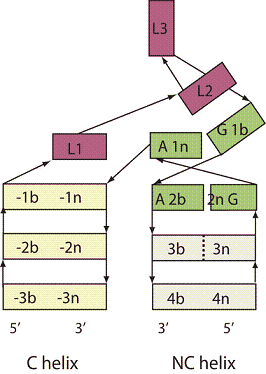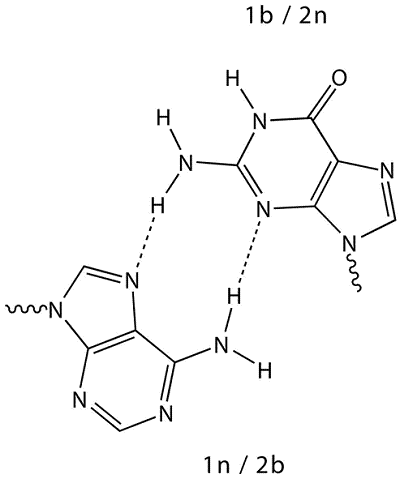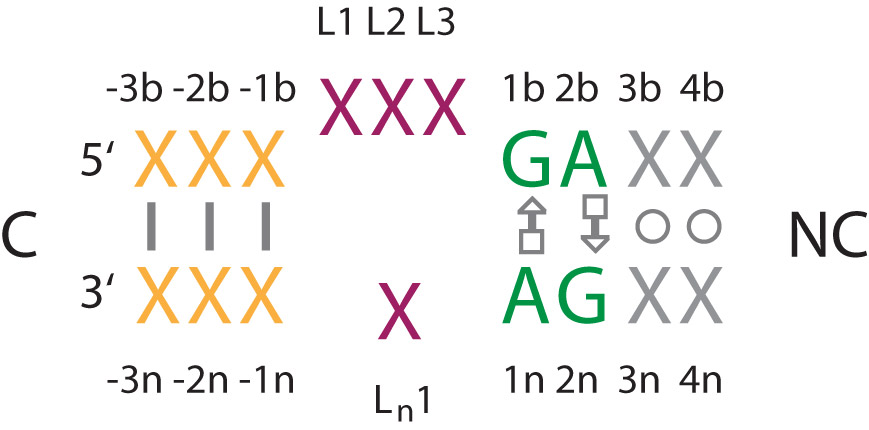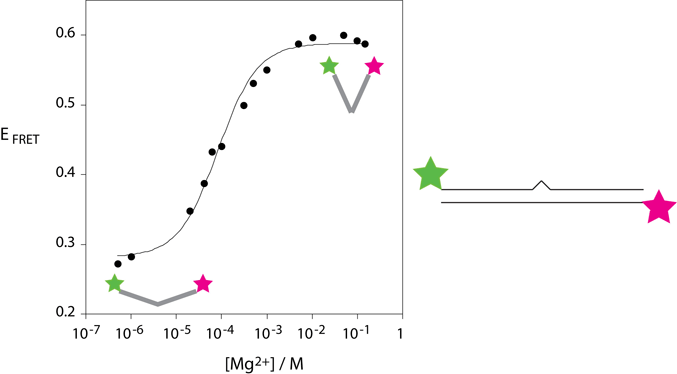What is a kink-turn motif ?
The kink-turn (usually abbreviated to k-turn) is a widespread structural motif in RNA, first noted as a repeated structural element in the large ribosomal subunit by the Steitz lab (1). It introduces a very tight kink into the axis of helical RNA. It clearly plays an important structural role in RNA, and is significant in many aspects of RNA function including translation, modification and splicing, as well as genetic regulation.
The sequence of Kt-7, an almost canonical k-turn found in the 50S subunit of the Haloarcula marismortui ribosome.
The standard k-turn comprises a three-nucleotide bulge flanked on its 3’ side by A•G and G•A basepairs (N-C stem), and on its 5’ side by a section of regular basepairing (C stem) (1).
The structure of a generic k-turn. A schematic of the structure is shown on the left, and the structure of Kt-7 in the H. marismortui ribosome is shown on the right.
Kt-7 of the 23S rRNA of the H. marismortui ribosome is close to the consensus sequence for k-turns. The structure introduces a pronounced kink in the RNA (from whence its name), with an included angle between the axes of ~ 50°. The minor grooves of the two helices are juxtaposed, and the conformation is stabilized by interactions between the stacked adenosines of the A•G basepairs and the C stem, and by stacking of the 5’ and central bases of the bulge on the ends of the C and N-C stems respectively.
The two A•G basepairs at the center of the k-turn. The A•G pairs of Kt-7 are shown in the molecular graphics.
The A•G basepairs are highly conserved. Both are trans sugar edge (G) to Hoogsteen edge (A) pairs, linked by potential hydrogen bonds G-N2 to A-N7 and A-N6 to G-N3. The 1b•1n pair is strongly buckled, while the bases of the 2n•2b pair are much closer to coplanarity. In some k-turns, the A-N6 to G-N3 hydrogen bond is not formed in the 2b•2n pair (see below). In the folded structure the minor groove edges of the two A•G pairs are juxtaposed with the minor groove of the opposing C helix to participate in A-minor interactions (2). The structural principles of k-turn geometry have been analyzed using isostericity matrices (3).
Many k-turns are bound by proteins in their natural state, at least some of which stabilize the kinked geometry. This is discussed further below.
A general nucleotide numbering system for k-turns
We have devised a universal nomenclature for the nucleotide positions in k-turns (4), thus avoiding the confusion that could arise from the many different numbering systems used in various crystal structures.
A systematic nomenclature for the nucleotides of a k-turn.
In this system, the unpaired bulge nucleotides are labelled Lj, where the index j is numbered sequentially from the 5’ side. Unpaired nucleotides on the opposite strand (found in a small fraction of k-turns) are designated Lnj, with j increasing 5’ to 3’. For all the remaining nucleotides, the two strands are differentiated by the suffix of b for the bulge-containing strand or n for the non-bulged strand. The nucleotides of the non-canonical stem are positively numbered from the first G•A mismatch in the 5’ to 3’ direction relative to the bulged strand, while those of the canonical stem are negatively numbered in the 3’ to 5’ direction. The numbering system can accommodate loops of different sizes.
Where are k-turns found ?
Some k-turns have been identified unequivocally, from their structure in situ within crystal structures of larger RNA structures or complexes. Others are assumed by virtue of their sequence, and perhaps their homology with known k-turns in related species. The pronounced kink of the k-turn can also be observed using a variety of biophysical methods, such as FRET (5).
The k-turn was first identified as a novel motif occurring multiple times in the ribosome (1,6,7). Further examples have been found in mRNA (8-11), and in riboswitches (12-16). They are very commonly found in C/D and H/ACA guide snoRNAs, and U3 snoRNA species (17-25). There is also a near-canonical k-turn in a stem-loop of the human U4 snRNA (26,27).
Metal ion-induced folding of k-turns
In order to adopt the tightly-kinked geometry, k-turn motifs require the presence of metal ions (5,27,28), or the binding of proteins (29). In the absence of either of these factors the RNA adopts a conformation that is more extended, like that of any three-nucleotide bulge in a duplex (30). The kinked conformation can be stabilized by addition of either divalent or monovalent metal ions (5), and folding can be treated as a two-state process.
Ion-induced folding of Kt-7 observed by the increase in fluorescence resonance energy transfer between terminally-attached fluorophores that become closer when the RNA adopts the kink turn conformation.
Folding is induced by micromolar concentrations of divalent ions, or millimolar concentrations of monovalent ions. For example, FRET analysis reveals that the folding of Kt-7 is achieved with a [Mg2+]1/2 = 80 µM, and a [Na+]1/2 = 30 mM (4).
There is no evidence for site-specific binding of metal ions to k-turns. It is likely that electrostatic interactions must be screened to allow the folded structure to achieve stability, and this is achieved by an ion atmosphere of loosely bound metal ions.
This suggests a dynamic character for k-turn structures, where they sample both the kinked and a more extended geometry, consistent with fluorescent lifetime measurements (31). Computer modelling studies have suggested that k-turns undergo hinge-like motions on a fast timescale (32-34).
Protein binding by k-turn RNA
The majority of k-turns are known to bind one or more proteins. A few are not, including that found in the SAM riboswitch (12), although it remains possible that in the cellular environment even that too is bound by proteins.
The archetypal k-turn binding protein is the ribosomal L7Ae and related proteins. These form a family of RNA-binding proteins including the eukaryotic and archaeal proteins L7Ae, L30e and S12e (35), the yeast Nhp2 and Snu13p proteins, and the human 15.5 kDa protein (36). Each of these proteins binds k-turn motifs in RNA, and some functional substitutions are tolerated (21). The assembly of the RNA methylation (box C/D) and pseudouridylation (box H/ACA) nucleoproteins are initiated by the binding of L7Ae-type proteins to k-turns contained within the guide RNA (37,38). The 15.5 kDa protein binds a k-turn of the U4 stem-loop in the U4-U6.U5 tri-snRNP (36). Crystal structures are available for the complexes of Archaeoglobus fulgidus L7Ae and box C/D RNA (22), Methanococcus jannaschii L7Ae and box H/ACA RNA (23) and the human 15.5 kDa protein and the U4 snRNA (26). In each case, the k-turn adopts the tightly-kinked conformation in the complex with the protein.
Crystal structure of the L7Ae protein complexed with the box C/D k-turn (22).
Even in the absence of added metal ions, the kinked conformation is induced by the binding of the protein. Moreover, the binding occurs with extremely high affinity. We have measured a dissociation constant of Kd = 10 pM for Archeoglobus fulgidus L7Ae binding to Kt-7 (39).
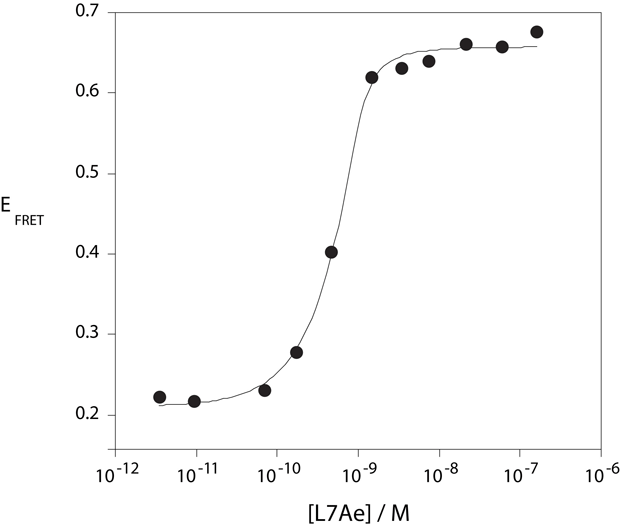
The binding of L7Ae to Kt-7 observed by FRET. The k-turn becomes folded into the kinked geometry on binding L7Ae, and thus adopting the structure that exhibits high FRET efficiency. Thus the position of equilibrium can be followed in this manner. The data are fitted to a two-state model. However, the binding is so tight that only an upper limit can be measured for the Kd. An accurate value was measured using kinetic measurements of association and dissociation rates (39).
In principle it could be imagined that k-turn folding could be promoted by protein binding in one of two ways, by passive selection of the kinked structure (conformational selection), or a more active process in which the protein manipulates the RNA structure (induced fit). The former requires an equilibrium between extended and folded k-turn structure in solution, as indicated in our measurement of fluorescent lifetimes (40). Real-time binding single-molecule experiments provide no evidence for a more extended intermediate down to a time resolution of 16 ms, supporting the conformational selection model (41).
Stabilization of k-turn structure by tertiary interactions
There is a third mechanism of stabilization, arising from longer-range tertiary interactions within the RNA. The k-turn introduces an abrupt transition in helical trajectory in the RNA helix that can be an important element in building the large-scale architecture of large RNA species. This is exemplified by the SAM-I riboswitch, where a long helix (P2) is kinked by a standard k-turn to allow the terminal loop to dock into a receptor in helix P4 (12,14).
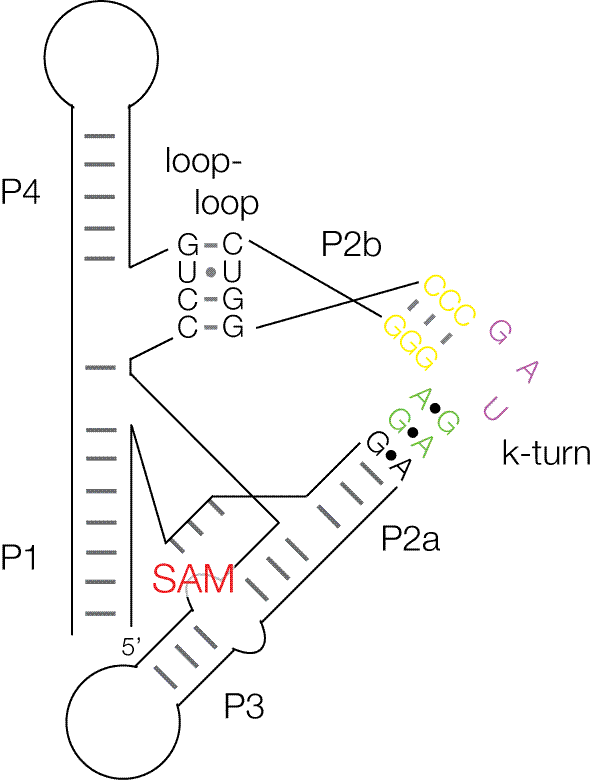
Schematic of the secondary structure of the SAM-I riboswitch. The k-turn is colored in our conventional manner. Note the loop-receptor interaction with the terminal loop of helix P2B.
This stabilizes the global fold of the riboswitch that creates the binding pocket for its ligand S-adenosyl methionine (SAM - shown in red above), and removal of the k-turn completely prevents SAM binding. Conversely though, the tertiary structure of the RNA stabilizes the local structure of the k-turn. We observed that a G2nA substitution prevented the k-turn from folding as an isolated duplex, yet allowed the riboswitch to retain full function indicative of unperturbed folding (42). Solving the crystal structure of the modified SAM-I riboswitch showed that the k-turn was folded completely normally, despite the presence of an A•A pair at the 2b•2n position.
Crystal structure of the SAM-I riboswitch containing a k-turn that has been modified by a G2nA substitution. A. The 3D structure of the complete riboswitch. B. The structure of the k-turn (colored) superimposed with that of the unmodified sequence (grey).
We conclude that the free energy of the tertiary interactions in the riboswitch is coupled to the folding of the k-turn so that an intrinsically unstable k-turn can fold normally.
Thus we see that the folded structure of the k-turn can be stabilized in three ways : 1. By neutralization of charge on addition of metal ions. 2. By the binding of proteins, including members of the L7Ae family. 3. By tertiary interactions within larger RNA species. There is likely to be an interplay between these different processes in larger RNA-protein assemblies.
Hydrogen bonding interactions that stabilize the kinked geometry
The majority of k-turns have a G•A pair at the 1b•1n position, and an A•G pair at the 2b•2n position. Sequence substitution of any of the four nucleotides is usually highly detrimental to folding (5). Both are trans sugar edge (G) to Hoogsteen edge (A) pairs, linked by potential hydrogen bonds G-N2 to A-N7 and A-N6 to G-N3. We have found experimentally that all four hydrogen bonds are important to the stability of the kinked form of the RNA. But the G-N2 to A-N7 hydrogen bonds of the two G•A pairs are the most critical to the stability of kinked form of Kt-7 in Mg2+ ions, so that folding is completely prevented by G to inosine substitutions at either position (39).
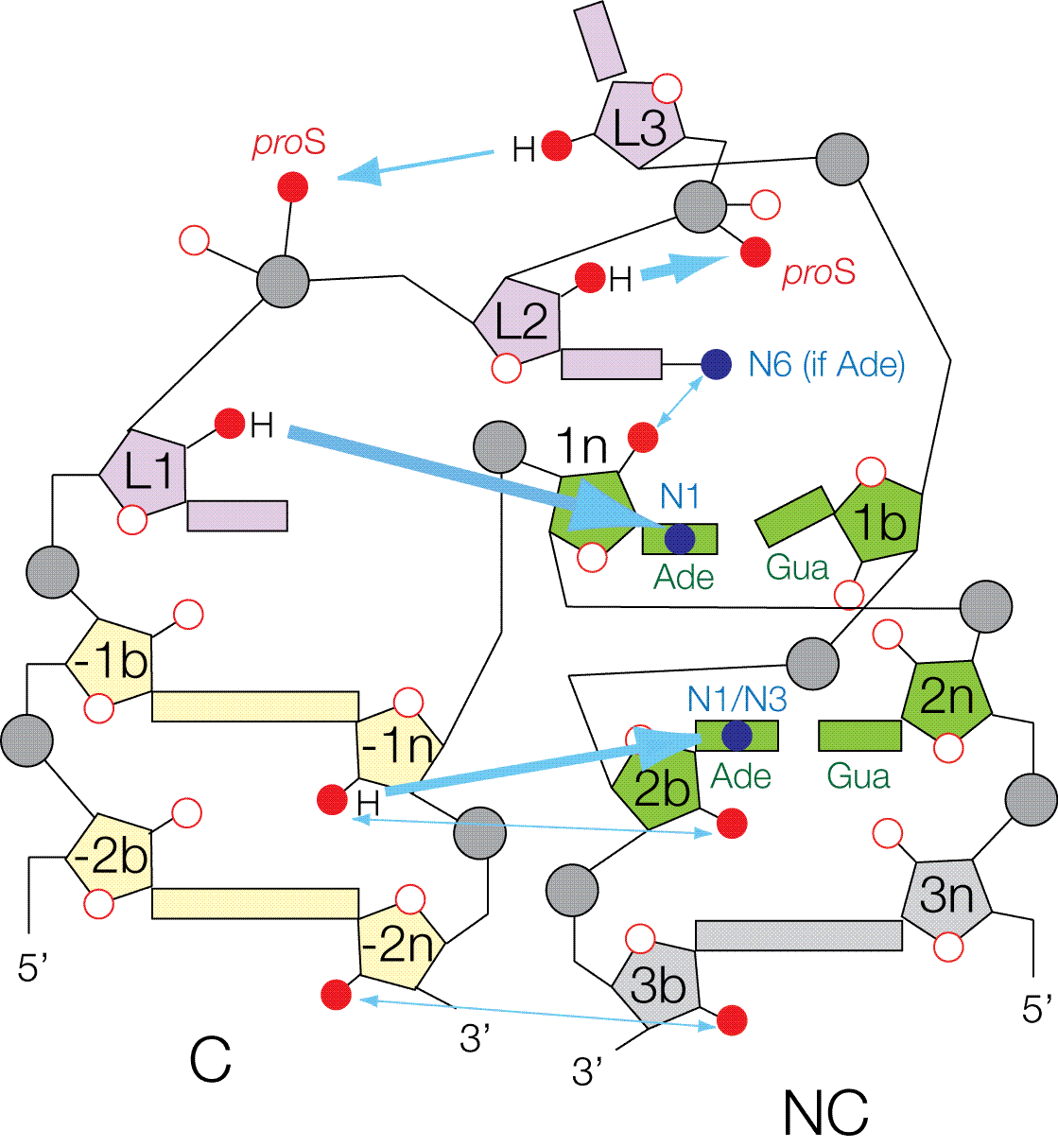
A cartoon summarizing the important hydrogen-bonding interactions involving O2’ groups that stabilize the kinked geometry of the k-turn. Hydrogen bonds are indicated by the cyan arrows, with a thickness that reflects their conservation and importance in stabilizing the structure.
In addition to the bonds linking the G•A pairs, a number of critical hydrogen bonds involving O2’ groups play a key role in stabilizing the kinked structure. These are summarized in the figure above. The most important are those in the core of the turn, and ribose-phosphate interactions around the bulge. These are strongly conserved in all k-turns, and critical to folding. Of these the single-most important hydrogen bond is one donated from the O2’ of L1 ribose to the N1 of the A1n in the kink-proximal A•G pair.
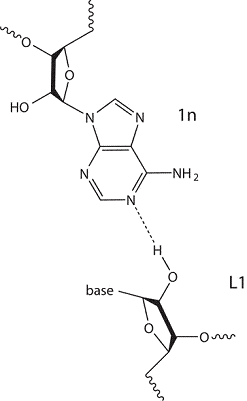
The critical hydrogen bond formed between the O2’ of L1 ribose to the N1 of the A1n.
This is present in all known k-turn structures, and removal of the O2’ from L1 completely prevents metal ion-induced folding (4). Another important hydrogen bond stabilizes the tight turn made at the loop of the k-turn. An interaction between the O2’ of L3 and the proS non-bridging O of the phosphate between L1 and L2 bridges the neck of the turn, and is observed in most k-turn crystal structures. Removal of the O2’ from L3 ribose in Kt-7 led to marked impairment of ion-induced folding (4).
Two important hydrogen bonds in the loop, seen here in Kt-7. One is donated from the O2’ of L3 to the proS non-bridging O of the phosphate between L1 and L2. The other is between the O2’ of L2 and the proS O of the L2/L3 phosphate group.
There is a further key hydrogen bond in the A-minor interaction between the C and NC helices, from the O2' of -1n to the nucleobase of the conserved adenine 2b. However, the acceptor can be N3 or N1, and this divides most of the known k-turn structures into two structural classes (31) . This is also true for the k-turns with an A•A pair at the 2b•2n position. The rotation of the adenine nucleobase required to present either N3 or N1 as acceptor affects the basepairing with the base at the 2n position. For example, where this is guanine, the G•A pair is bonded by two hydrogen bonds for the N3 class; however in the N1 class the A2b N6 to G2n N3 is too long to be considered hydrogen bonded.
Examples of the N3 and N1 classes of k-turn, showing the A-minor interaction between A2b and the O2' at the -1n position, and the hydrogen bonding between A2b and G2n. The red broken line in Kt-38 indicates an N-N distance of 4.7 Å, too long to be bonded.
k-turns that depart from the consensus sequence
Some k-turns ‘break the rules’ of the standard motif. We divide these into two classes :
1. The simple k-turns. These retain the same ordering of key nucleotides with respect to the primary sequence.
2. The complex k-turns. In these k-turns the key nucleotides do not map onto the primary sequence in a linear way.
Some of the simple k-turns have sequence changes that alter the seemingly essential G•A pairs. This is well exemplified by Kt-23 of the small ribosomal subunit, that exhibits frequent changes from the consensus in the 2n position.
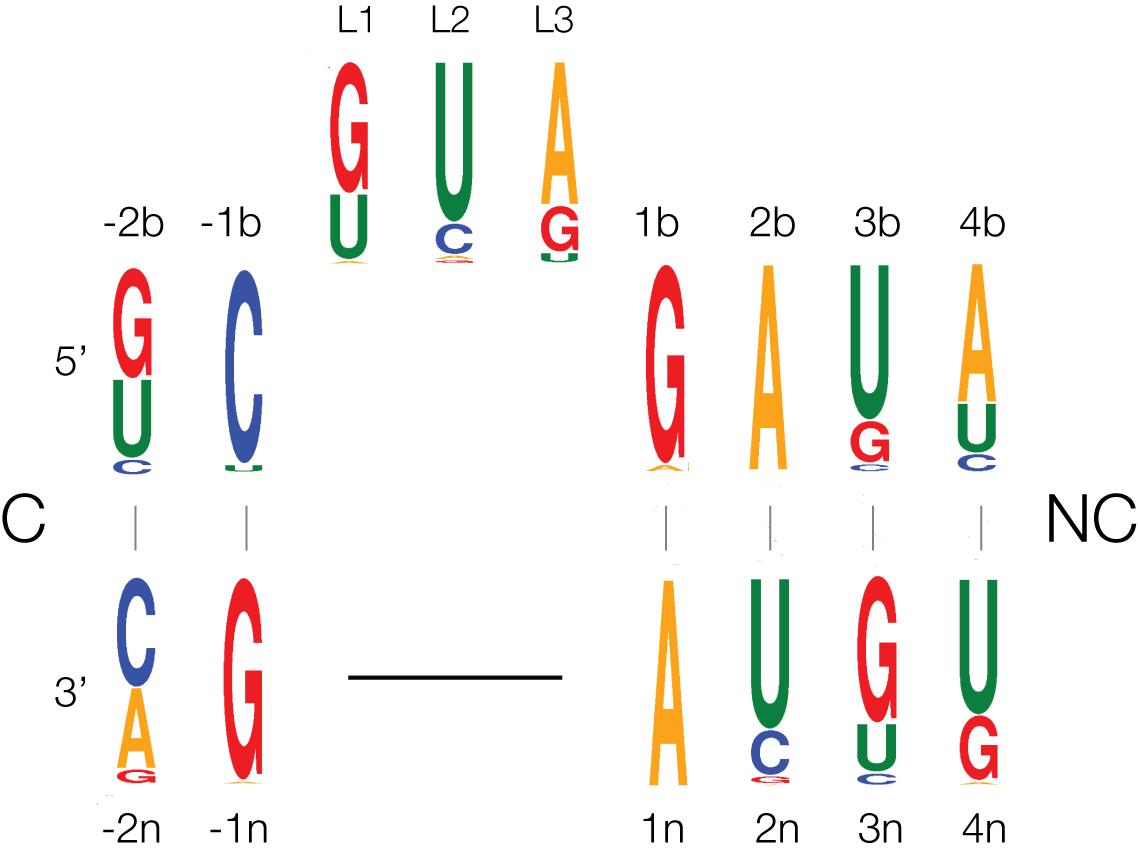
WebLogo (43) summary of Kt-23 sequences
In Kt-23 of Thermus thermophilus (6), the 2n nucleotide is uridine, forming a non-Watson-Crick A•U pair with A2b. Although making the same change in Kt-7 totally prevents folding from occurring, Kt-23 folds efficiently on addition of magnesium ions, and its structure in the 30S ribosomal subunit is superimposable with that of Kt-7 (44).
Overlay of the crystal structures of Kt-7 (blue) and Kt-23 (red), showing the closely similar positions of the adenine nucleobases at the 1n and 2b positions.
A relatively rare subset of Kt-23 sequences have adenine at the 2n position, giving a potential A•A pair at the 2b•2n position. One such example is found in Thelohania solenopsae. This can be folded into the k-turn conformation by the binding of L7Ae, or by tertiary interactions in the SAM-I riboswitch (45). The crystal structure of the latter construct shows that the RNA adopts standard k-turn geometry, with the 1n and 2b adenine nucleobases directed into the C helix minor groove as normal, and preservation of the standard hydrogen bonding pattern (45). This is an N1 structure, and consequently there is no hydrogen bond between A2b N6 and A2n N3 (N-N distance 4.7 Å).
The structure of the A2b•A2n pair observed in the crystal structure of T. solenopsae Kt-23 (45). The electron density is the calculated composite omit map.
The complex k-turns exhibit more radical departure from the simple k-turns such as H. marismortui Kt-7, where the key nucleotides appear to be ‘out of order’ (as in T. thermophilus Kt-11), and can even pass between strands (as in H. marismortui Kt-15).

The connectivity of the nucleotides in the structures of H. marismortui Kt-15, and T. thermophilus Kt-11.
Despite the major departures of the sequences from the conventional k-turn, both form standard k-turn structures in the ribosome. We recommend naming the nucleotides according to their location in the structure, rather than their position in the linear sequence. Thus the adenine paired with G2n in Kt-15 is best termed 2b, even though it is covalently located on the non-bulged strand.
In some species k-turns are functionally replaced by structures that are strongly kinked, yet not k-turns (if we define k-turns by the A•G pairs and the juxtaposition of the N and NC helix minor grooves). For example, the B. subtilis lysine riboswitch contains a probable k-turn that introduces a kink into the structure required for the tertiary structure (13), yet in Thermatoga maritima this is replaced by a sequence that is plainly not a k-turn (40). The latter may well be a point of flexibility rather than an intrinsic kink, but it functions in a similar manner in situ. In another example, RNase P of T. maritima contains a sequence (termed a pk turn) that is kinked similarly to a k-turn (47) , but lacks the G•A pairs and cross-strand hydrogen bonding. However the pk-turn and the k-turn are functionally exchangeable between the SAM-I riboswitch and RNase P (40). In the crystal structure of the group I intron ribozyme of Azoarcus, Strobel and colleagues found a sequence that they termed the ‘reverse k-turn’ (48). This motif has an A•A pair at the putative 1b•1n position, and bends in the opposite direction compared to conventional k-turns, so that the major grooves become juxtaposed. We feel that this should not be classified as a k-turn because it lacks all the key elements that define a k-turn.
A role for k-turns in building complex RNA structures ?
Kink turns could play a key role in RNA architecture and the biogenesis of large assemblies. This includes the formation of functional RNA-protein complexes such as the box C/D in guided methylation, where the first even is the binding of an L7Ae-related protein to a k-turn. On a larger scale, the ribosome has many k-turns that are bound by a variety of different proteins. The dynamic character of the k-turn should provide opportunity for RNA to explore conformational space, but once folded the tight kink can provide long-range organization of the structure in a delicate interplay between the local structure and tertiary interactions. This may provide flexibility during the assembly of the structure, with subsequent fixation by the high-affinity binding of specific proteins to k-turns.
References
1. Klein, D.J., Schmeing, T.M., Moore, P.B. and Steitz, T.A. (2001) The kink-turn: a new RNA secondary structure motif. EMBO J., 20, 4214-4221.
2. Nissen, P., Ippolito, J.A., Ban, N., Moore, P.B. and Steitz, T.A. (2001) RNA tertiary interactions in the large ribosomal subunit: The A-minor motif. Proc. Natl. Acad. Sci. USA, 98, 4899-4903.
3. Lescoute, A., Leontis, N.B., Massire, C. and Westhof, E. (2005) Recurrent structural RNA motifs, isostericity matrices and sequence alignments. Nucleic Acids Res., 33, 2395-2409.
4. Liu, J. and Lilley, D.M.J. (2007) The role of specific 2'-hydroxyl groups in the stabilization of the folded conformation of kink-turn RNA. RNA, 13, 200-210.
5. Goody, T.A., Melcher, S.E., Norman, D.G. and Lilley, D.M.J. (2004) The kink-turn motif in RNA is dimorphic, and metal ion dependent. RNA, 10, 254-264.
6. Wimberly, B.T., Brodersen, D.E., Clemons, W.M., Jr., Morgan-Warren, R.J., Carter, A.P., Vonrhein, C., Hartsch, T. and Ramakrishnan, V. (2000) Structure of the 30S ribosomal subunit. Nature, 407, 327-339.
7. Schuwirth, B.S., Borovinskaya, M.A., Hau, C.W., Zhang, W., Vila-Sanjurjo, A., Holton, J.M. and Cate, J.H. (2005) Structures of the bacterial ribosome at 3.5 Å resolution. Science, 310, 827-834.
8. Mao, H., White, S.A. and Williamson, J.R. (1999) A novel loop-loop recognition motif in the yeast ribosomal protein L30 autoregulatory RNA complex. Nature Struct. Biol., 6, 1139-1147.
9. Winkler, W.C., Grundy, F.J., Murphy, B.A. and Henkin, T.M. (2001) The GA motif: an RNA element common to bacterial antitermination systems, rRNA, and eukaryotic RNAs. RNA, 7, 1165-1172.
10. Allmang, C., Carbon, P. and Krol, A. (2002) The SBP2 and 15.5 kD/Snu13p proteins share the same RNA binding domain: identification of SBP2 amino acids important to SECIS RNA binding. RNA, 8, 1308-1318.
11. White, S.A., Hoeger, M., Schweppe, J.J., Shillingford, A., Shipilov, V. and Zarutskie, J. (2004) Internal loop mutations in the ribosomal protein L30 binding site of the yeast L30 RNA transcript. RNA, 10, 369-377.
12. Montange, R.K. and Batey, R.T. (2006) Structure of the S-adenosylmethionine riboswitch regulatory mRNA element. Nature, 441, 1172-1175.
13. Blouin, S. and Lafontaine, D.A. (2007) A loop loop interaction and a K-turn motif located in the lysine aptamer domain are important for the riboswitch gene regulation control. RNA, 13, 1256-12567.
14. Heppell, B. and Lafontaine, D.A. (2008) Folding of the SAM aptamer is determined by the formation of a K-turn-dependent pseudoknot. Biochemistry, 47, 1490-1499.
15. Smith, K.D., Lipchock, S.V., Ames, T.D., Wang, J., Breaker, R.R. and Strobel, S.A. (2009) Structural basis of ligand binding by a c-di-GMP riboswitch. Nature Struct. Mol. Biol., 16, 1218-1223.
16. Baird, N.J. and Ferre-D'Amare, A.R. (2013) Modulation of quaternary structure and enhancement of ligand binding by the K-turn of tandem glycine riboswitches. RNA, 19, 167-176.
17. Watkins, N.J., Dickmanns, A. and Lührmann, R. (2002) Conserved stem II of the box C/D motif is essential for nucleolar localization and is required, along with the 15.5K protein, for the hierarchical assembly of the box C/D snoRNP. Mol. Cell Biol., 22, 8342-8352.
18. Kuhn, J.F., Tran, E.J. and Maxwell, E.S. (2002) Archaeal ribosomal protein L7 is a functional homolog of the eukaryotic 15.5kD/Snu13p snoRNP core protein. Nucleic Acids Res., 30, 931-941.
19. Bortolin, M.L., Bachellerie, J.P. and Clouet-d'Orval, B. (2003) In vitro RNP assembly and methylation guide activity of an unusual box C/D RNA, cis-acting archaeal pre-tRNA(Trp). Nucleic Acids Res., 31, 6524-6535.
20. Marmier-Gourrier, N., Clery, A., Senty-Segault, V., Charpentier, B., Schlotter, F., Leclerc, F., Fournier, R. and Branlant, C. (2003) A structural, phylogenetic, and functional study of 15.5-kD/Snu13 protein binding on U3 small nucleolar RNA. RNA, 9, 821-838.
21. Rozhdestvensky, T.S., Tang, T.H., Tchirkova, I.V., Brosius, J., Bachellerie, J.-P. and Hüttenhofer, A. (2003) Binding of L7Ae protein to the K-turn of archaeal snoRNAs: a shared RNA binding motif for C/D and H/ACA box snoRNAs in Archaea. Nucleic Acids Res., 31, 869-877.
22. Moore, T., Zhang, Y., Fenley, M.O. and Li, H. (2004) Molecular basis of box C/D RNA-protein Interactions; Cocrystal structure of archaeal L7Ae and a box C/D RNA. Structure, 12, 807-818.
23. Hamma, T. and Ferré-D'Amaré, A.R. (2004) Structure of protein L7Ae bound to a K-turn derived from an archaeal box H/ACA sRNA at 1.8 Å resolution. Structure, 12, 893-903.
24. Szewczak, L.B., Gabrielsen, J.S., Degregorio, S.J., Strobel, S.A. and Steitz, J.A. (2005) Molecular basis for RNA kink-turn recognition by the h15.5K small RNP protein. RNA, 11, 1407-1419.
25. Youssef, O.A., Terns, R.M. and Terns, M.P. (2007) Dynamic interactions within sub-complexes of the H/ACA pseudouridylation guide RNP. Nucleic Acids Res., 35, 6196-6206.
26. Vidovic, I., Nottrott, S., Hartmuth, K., Lührmann, R. and Ficner, R. (2000) Crystal structure of the spliceosomal 15.5 kD protein bound to a U4 snRNA fragment. Molec. Cell, 6, 1331-1342.
27. Wozniak, A.K., Nottrott, S., Kuhn-Holsken, E., Schroder, G.F., Grubmuller, H., Lührmann, R., Seidel, C.A. and Oesterhelt, F. (2005) Detecting protein-induced folding of the U4 snRNA kink-turn by single-molecule multiparameter FRET measurements. RNA, 11, 1545-1554.
28. Matsumura, S., Ikawa, Y. and Inoue, T. (2003) Biochemical characterization of the kink-turn RNA motif. Nucleic Acids Res., 31, 5544-5551.
29. Turner, B., Melcher, S.E., Wilson, T.J., Norman, D.G. and Lilley, D.M.J. (2005) Induced fit of RNA on binding the L7Ae protein to the kink-turn motif. RNA, 11, 1192-1200.
30. Lilley, D.M.J. (1995) Kinking of DNA and RNA by base bulges. Proc. Natl. Acad. Sci. USA, 92, 7140-7142.
31. Daldrop, P. and Lilley, D.M.J. (2012) The plasticity of a structural motif in RNA: structural polymorphism of a kink turn as a function of its environment. RNA, In the press.
32. Razga, F., Koca, J., Sponer, J. and Leontis, N.B. (2005) Hinge-like motions in RNA Kink-turns: The role of the second A-minor motif and nominally unpaired bases. Biophys. J., 5, 3466-3485.
33. Cojocaru, V., Klement, R. and Jovin, T.M. (2005) Loss of G-A base pairs is insufficient for achieving a large opening of U4 snRNA K-turn motif. Nucleic Acids Res, 33, 3435-3446.
34. Razga, F., Zacharias, M., Reblova, K., Koca, J. and Sponer, J. (2006) RNA kink-turns as molecular elbows: hydration, cation binding, and large-scale dynamics. Structure, 14, 825-835.
35. Koonin, E.V., Bork, P. and Sander, C. (1994) A novel RNA-binding motif in omnipotent suppressors of translation termination, ribosomal proteins and a ribosome modification enzyme? Nucleic Acids Res., 22, 2166-2167.
36. Nottrott, S., Hartmuth, K., Fabrizio, P., Urlaub, H., Vidovic, I., Ficner, R. and Lührmann, R. (1999) Functional interaction of a novel 15.5kD [U4/U6.U5] tri-snRNP protein with the 5' stem-loop of U4 snRNA. EMBO J., 18, 6119-6133.
37. Kiss-Laszlo, Z., Henry, Y., Bachellerie, J.P., Caizergues-Ferrer, M. and Kiss, T. (1996) Site-specific ribose methylation of preribosomal RNA: a novel function for small nucleolar RNAs. Cell, 85, 1077-1088.
38. Ganot, P., Bortolin, M.L. and Kiss, T. (1997) Site-specific pseudouridine formation in preribosomal RNA is guided by small nucleolar RNAs. Cell, 89, 799-809.
39. Turner, B. and Lilley, D.M. (2008) The importance of G.A hydrogen bonding in the metal ion- and protein-induced folding of a kink turn RNA. J. Molec. Biol., 381, 431-442.
40. Daldrop, P., Masquida, B. and Lilley, D.M.J. (2013) The functional exchangeability of pk- and k-turns in RNA structure. RNA Biol., in the press.
41. Wang, J., Fessl, T., Schroeder, K.T., Ouellet, J., Liu, Y., Freeman, A.D. and Lilley, D.M. (2012) Single-Molecule Observation of the Induction of k-Turn RNA Structure on Binding L7Ae Protein. Biophysical J., 103, 2541-2548.
42. Schroeder, K.T., Daldrop, P. and Lilley, DM., (2011) RNA tertiary interactions in a riboswitch stabilize the structure of a kink turn. Structure, 19, 1233-40.
43. Crooks, G.E., Hon, G., Chandonia, J.M. and Brenner, S.E. (2004) WebLogo: a sequence logo generator. Genome Res., 14, 1188-1190.
44. Schroeder, K.T. and Lilley, D.M.J. (2009) Ion-induced folding of a kink turn that departs from the conventional sequence. Nucleic Acids Res., 37, 7281-7289.
45. Schroeder, K.T., Daldrop, P., McPhee, S.A. and Lilley, DM., (2012) Structure and folding of a rare, natural kink turn in RNA with an A.A pair at the 2b.2n position RNA, 18, 1257-1266.
46. Garst, A.D., Heroux, A., Rambo, R.P. and Batey, R.T. (2008) Crystal structure of the lysine riboswitch regulatory mRNA element. J. Biol. Chem., 283, 22347-22351.
47. Meyer, M., Westhof, E. and Masquida, B. (2012) A structural module in RNase P expands the variety of RNA kinks. RNA biology, 9, 254-260.
48. Strobel, S.A., Adams, P.L., Stahley, M.R. and Wang, J. (2004) RNA kink turns to the left and to the right. RNA, 10, 1852-1854.

